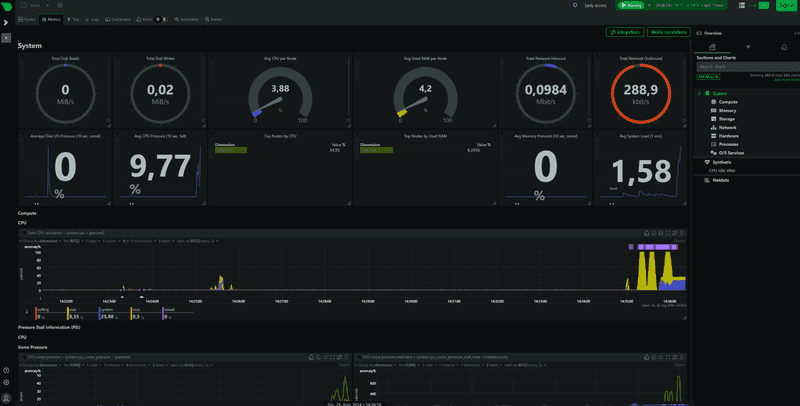Introduction
In this tutorial, we're going to install Netdata and learn how to prevent public access to its web interface, since Netdata doesn't provide authentication by itself.
Netdata is a distributed, real-time performance and health monitoring tool for systems and applications. It is a highly-optimized monitoring agent that can be installed on Linux servers.
Prerequisites
- A fresh CentOS or Ubuntu installation (almost all mainstream distributions are supported though)
- Access to the root user or a user with sudo permissions
Example terminology
- Domain:
example.com - Username:
holu
Step 1 - Install and configure Netdata
Step 1.1 - Installation
In order to install the latest version of Netdata, you can use a bash script provided by Netdata.
There are alternative methods of installation which you can check out on the Netdata website.
Simply run the following in your terminal:
bash <(curl -Ss https://get.netdata.cloud/kickstart.sh)Example output:
--- Using /tmp/netdata-kickstart-X3dtqRNrP9 as a temporary directory. ---
--- Checking for existing installations of Netdata... ---
--- No existing installations of netdata found, assuming this is a fresh install. ---
--- Attempting to install using native packages... ---
--- Checking for availability of repository configuration package. ---
[/tmp/netdata-kickstart-X3dtqRNrP9]$ /usr/bin/curl --fail -q -sSL --connect-timeout 10 --retry 3 --output /tmp/netdata-kickstart-X3dtqRNrP9/netdata-repo-edge_3-2+ubuntu24.04_all.deb https://repo.netdata.cloud/repos/repoconfig/ubuntu/noble/netdata-repo-edge_3-2+ubuntu24.04_all.deb
OK
Root privileges required to run env apt-get update
[/tmp/netdata-kickstart-X3dtqRNrP9]$ sudo env apt-get update
[sudo] password for holu:You should see something like the example output above. If you're not running the script as root, it'll ask you for your sudo password.
After providing the sudo password, it'll let you know what necessary dependencies are missing, so you can install them by entering y.
The following additional packages will be installed:
debian-keyring
The following NEW packages will be installed:
debian-keyring netdata-repo-edge
0 upgraded, 2 newly installed, 0 to remove and 106 not upgraded.
Need to get 31.3 MB/31.3 MB of archives.
After this operation, 33.1 MB of additional disk space will be used.
Do you want to continue? [Y/n] y
The following NEW packages will be installed:
libbson-1.0-0t64 libmongoc-1.0-0t64 libmongocrypt0 libnetfilter-acct1 libsnappy1v5 libutf8proc3 netdata netdata-plugin-apps
netdata-plugin-chartsd netdata-plugin-debugfs netdata-plugin-ebpf netdata-plugin-go netdata-plugin-network-viewer netdata-plugin-nfacct
netdata-plugin-perf netdata-plugin-pythond netdata-plugin-slabinfo netdata-plugin-systemd-journal
0 upgraded, 18 newly installed, 0 to remove and 107 not upgraded.
Need to get 45.2 MB of archives.
After this operation, 152 MB of additional disk space will be used.
Do you want to continue? [Y/n] y
Once done, Netdata is automatically started and enabled on systemd. Check the status via systemctl:
sudo systemctl status netdataIf it is not running yet, you can start it with:
sudo systemctl enable netdata
sudo systemctl start netdataYou can now access Netdata web interface via:
<your_host>:19999Step 1.2 - Configuration
Now we need to make sure Netdata only listens on 127.0.0.1 since we don't want the web interface to be accessible on the internet.
Open the /etc/netdata/netdata.conf file with an editor of your choice.
If the file is still empty, you can download the latest version of this file, using:
sudo wget -O /etc/netdata/netdata.conf http://localhost:19999/netdata.conf
sudo nano /etc/netdata/netdata.confFind the [web] section and uncomment the bind to setting. Replace it with the following:
bind to = 127.0.0.1Now, apply the change:
sudo systemctl restart netdata
sudo systemctl status netdataAfter the restart, you can no longer access the Netdata web interface at <your_host>:19999.
Step 2 - Install and configure NGINX
In this step, we will install NGINX to set up a reverse proxy so we're able to access the Netdata web interface securely.
Step 2.1 - Installation
You can install NGINX and apache2-utils by running the following commands: (apache2-utils is needed for the second part of this step)
-
Debian/Ubuntu:
sudo apt install nginx apache2-utils -
Redhat/CentOS/Fedora:
sudo yum install nginx httpd-tools
Your NGINX setup should be good to go.
nginx -version
sudo systemctl status nginxIf it is not running yet, you can start it with:
sudo systemctl enable nginx
sudo systemctl start nginxStep 2.2 - Setup Authentication
Run this command to create a username-password pair:
Replace
holuwith a username of your choice.
sudo htpasswd -c /etc/nginx/.htpasswd holuPress Enter and type the password for holu at the prompts.
Confirm that the username-password pair has been created by running:
cat /etc/nginx/.htpasswdStep 2.3 - Configuration
Open your NGINX configuration file (nginx.conf) and find the http block. Your nginx.conf file is usually located in /usr/local/nginx/conf, /etc/nginx, or /usr/local/etc/nginx-
Add the following lines into your http block:
Replace
example.comwith your own domain.
upstream backend {
server 127.0.0.1:19999;
keepalive 64;
}
server {
listen 80;
# Uncomment the line below for IPv6
#listen [::]:80;
server_name example.com;
auth_basic "Protected";
auth_basic_user_file /etc/nginx/.htpasswd;
location / {
proxy_set_header X-Forwarded-Host $host;
proxy_set_header X-Forwarded-Server $host;
proxy_set_header X-Forwarded-For $proxy_add_x_forwarded_for;
proxy_pass http://backend;
proxy_http_version 1.1;
proxy_pass_request_headers on;
proxy_set_header Connection "keep-alive";
proxy_store off;
}
}Save the configuration file and close it. Then verify the configuration to check if everything is OK.
sudo nginx -tGo ahead and reload NGINX if there was no error:
sudo systemctl reload nginxOpen your browser and navigate to the public IP of your server or <example.com>. Use your username-password pair to access the web interface.
Conclusion
In this tutorial we installed Netdata and used NGINX to set up a reverse proxy so we're able to prevent public access to the Netdata web interface.
